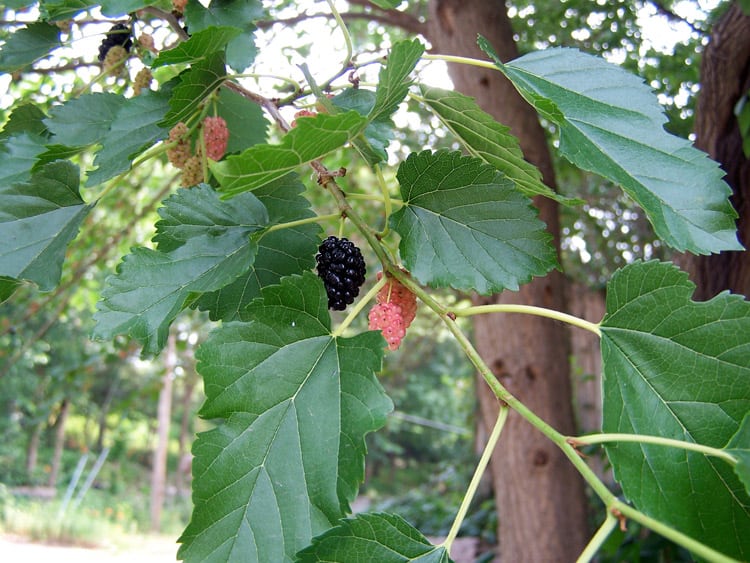
My nails have been black for over a week now. This is the price I pay for picking mulberries, whose juice has a staining power the military might want to look into. Under the guilty tree, a (doomed) white car has been parked for the past nine days, and I know from experience that its hood will never be pure white again: pale pink blooms will adorn its surface, souvenirs of its time beneath that tree.
Perhaps it’s not surprising that the native mulberry, Morus rubra, is disappearing from Saint Paul. If you ask a random sampling of people what they think of when they think mulberry, you’ll get a single reply: “Messy.” Messy trees that stain automobiles have no place here in 2008, apparently. And that is sad and telling.
The mulberry was once revered as a source of fine summer fruit. It’s an odd sort of fruit: superficially, it looks like a berry, but in fact each of its jewel-like, super-soft and super-juicy lobes is an individual fruit. This accounts for the sturdy central stem, which can’t be easily pulled off, as it can be from an actual berry. Each lobe is attached to that stem; the best you can do is to nip it off above the lobes. This labor of love is what accounts for my blackened fingers.
At our latitude, the only species of mulberry that dependably flourishes is the red mulberry (M. rubra). Behind the rehabbed warehouse where I live in Lowertown stands what we residents call the dog walk. The southern border of the dog walk is dense with struggling, elderly trees: a diseased elm; a few ash; a large cottonwood. Tucked among them stand five mulberries, and in June, these challenged trees produce. And produce and produce, in waves of fruit that start white, progress to pink, deepen to inky purple-black.
To honor them and the generations of Saint Paulites who once welcomed these trees’ summer bounty, I go among them and pick their fruit. They’re unlikely to stand there much longer; sooner or later—and probably sooner—the city will respond to complaints about their messiness, about their violence against cars. So I gather and make tarts from them while I can.
If there’s a mulberry tree in your neighborhood, consider yourself lucky. The mulberry has become so obscure that recent cookbooks don’t even mention it, so know that you will be cooking what amounts to a culinary fossil.
M. rubrus is tarter and more intense than Asian varieties, so it makes, to my mind, a superior jam, jelly, or tart. If you use mulberries for preserves, put them through a foodmill to rid yourself of their central stem. If you use them for a pie or tart, you must nip out the visible parts of each stem, so reconcile yourself to hands that bear the stains of summer.
Mulberry-Rhubarb Tart
Heat oven to 425°F
2 cups fresh mulberries, visible stems removed
1 cup of fresh rhubarb, sliced into 1/4-inch pieces
1 scant cup of sugar
1 tsp. kosher salt
11/2 Tbs. cornstarch
Let mixture stand for an hour; stir it once or twice to evenly distribute the ingredients.
Make a single pie or tart crust. Bake blind until lightly browned. Wait three minutes; coat inside of crust with beaten egg white to seal it.
Add fruit to crust and bake until crust is browned and rhubarb is cooked through.
Glaze with 1/4 cup of fruit juice that’s been boiled with 1 teaspoon of cornstarch for 30-40 seconds.
Art By: